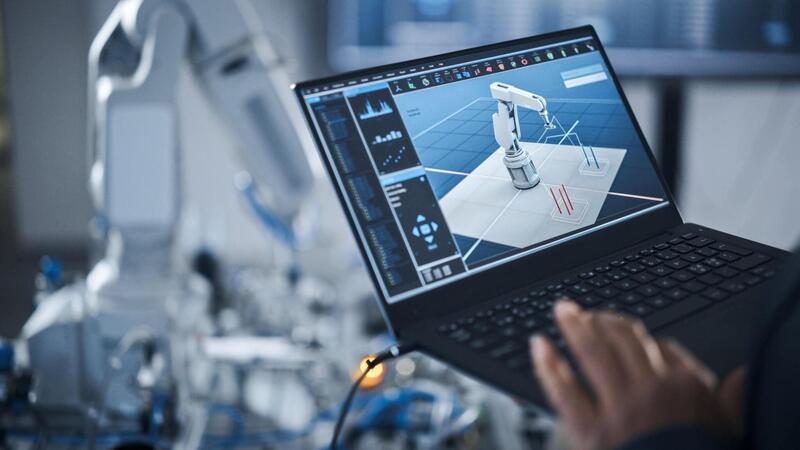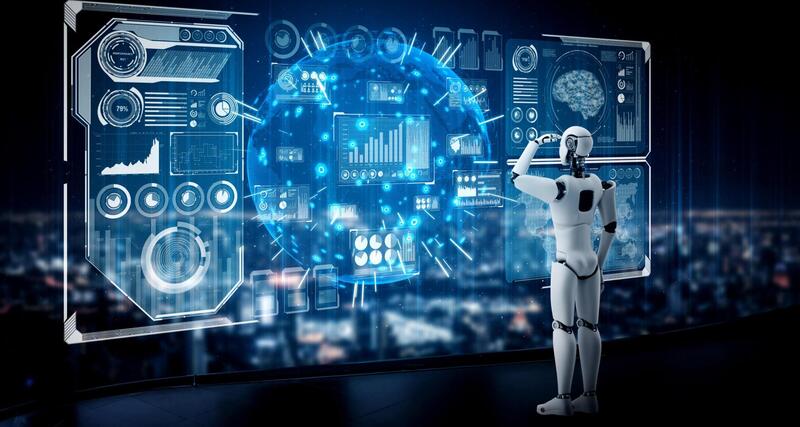Introduction to Robotic Process Automation (RPA)
Automation has been a transformative force in modern business, revolutionizing the way organizations operate. From streamlining repetitive tasks to enhancing operational efficiency, automation has become a cornerstone of business optimization.
At the forefront of the automation revolution is Robotic Process Automation (RPA). RPA represents a pivotal advancement in technology, where software robots are deployed to execute rule-based tasks that traditionally required human intervention. These software robots, or "bots," replicate the actions of a human user interacting with digital systems, applications, and data.
The essence of RPA lies in its ability to handle mundane and repetitive tasks with precision and efficiency. By automating these routine processes, organizations can achieve substantial time and cost savings. RPA acts as a virtual workforce, executing tasks tirelessly around the clock, freeing up human resources for more complex and strategic activities.
The introduction of RPA has democratized automation, enabling organizations of all sizes to leverage this technology to enhance productivity and operational efficiency. Its user-friendly nature allows business users to design, deploy, and manage automation processes without extensive programming expertise.

Significance of Automation in Enhancing Efficiency
Automation is not merely a convenience or a technological trend; it has become a strategic imperative for modern businesses. The significance of automation lies in its ability to bring about transformative changes that directly impact operational efficiency.
Reducing Errors:
Automation minimizes the risk of human errors associated with repetitive tasks. By eliminating manual intervention, organizations can achieve a higher degree of accuracy in their processes, leading to improved product or service quality.
Minimizing Operational Costs:
The efficiency gained through automation translates into cost savings. By optimizing workflows, reducing processing times, and eliminating unnecessary steps, organizations can achieve significant cost efficiencies.
Accelerating Task Completion Times:
Automation excels in expediting task completion. Processes that would take hours or days to complete manually can be accomplished in a fraction of the time with automation, contributing to faster turnaround times and improved customer satisfaction.
In essence, the strategic deployment of automation aligns with organizational goals of staying competitive, agile, and resilient in a dynamic business environment. As industries continue to evolve, the role of automation, particularly in the form of RPA, becomes increasingly integral to achieving operational excellence.
Traditional Robotic Process Automation (RPA)
Explanation of RPA and its Core Principles
Robotic Process Automation (RPA) operates on a set of defined principles aimed at automating routine tasks and processes. At its core, RPA leverages software bots, also known as robots or bots, to execute actions within digital systems. These bots are programmed to follow predefined rules and structured inputs, mimicking human interactions with user interfaces, applications, and data systems.
The fundamental principles of RPA include:
Predefined Rules:
RPA relies on explicit instructions or rules set by developers. These rules dictate the sequence of actions the software bot should perform during the automation process.
Structured Inputs:
RPA processes are designed to handle structured data inputs. This could include data in the form of spreadsheets, databases, or other well-organized formats. The predictability of input data is crucial for the accuracy and reliability of RPA.
Task Automation:
RPA is particularly effective in automating rule-based, repetitive tasks that follow a predictable pattern. Examples include data entry, form filling, and calculations that require a sequence of steps.
Emulation of Human Actions:
RPA bots emulate human actions within digital systems. This emulation extends to tasks such as mouse clicks, keyboard inputs, and navigation through user interfaces.
By adhering to these principles, RPA brings efficiency and precision to routine tasks, allowing organizations to enhance productivity and reduce the burden on human resources.
Key Features and Limitations of Traditional RPA
Efficiency:
RPA excels in automating repetitive tasks with speed and accuracy, leading to increased operational efficiency.
Cost Savings:
By automating routine processes, organizations can achieve significant cost savings through reduced labor costs and increased output.
User-Friendly:
Traditional RPA platforms are designed to be user-friendly, enabling business users to create and manage automation processes without extensive coding knowledge.
Limitations:
Handling Unstructured Data:
Traditional RPA faces challenges when dealing with unstructured or semi-structured data. Processes heavily reliant on human interpretation may require additional cognitive capabilities.
Adaptation to Dynamic Processes:
RPA is best suited for stable, rule-based processes. Adapting to dynamic or rapidly changing processes may pose challenges as frequent updates to automation scripts may be necessary.
Scalability and Flexibility:
While effective for specific tasks, traditional RPA may encounter scalability issues when applied to broader and more complex workflows. Adapting to changes in business processes may require additional effort.

Real-world Examples of RPA Implementations
Across industries, organizations have successfully implemented RPA to streamline operations and achieve tangible benefits. Examples of RPA implementations include:
Data Entry Automation:
RPA is often used to automate data entry tasks, reducing errors and processing times.
Invoice Processing:
Organizations utilize RPA to automate the extraction of data from invoices, accelerating the payment processing cycle.
Customer Onboarding:
RPA assists in automating customer onboarding processes, ensuring swift and error-free handling of documentation.
HR Processes:
From employee onboarding to payroll processing, RPA is employed to automate various HR-related tasks.
Achievements and Challenges in RPA Adoption
Achievements:
Cost Savings: Organizations adopting RPA often experience significant cost savings through the reduction of manual labor and improved process efficiency.
Increased Productivity: RPA contributes to heightened productivity by completing routine tasks at a faster pace, allowing human resources to focus on more strategic initiatives.
Error Reduction: The precision of RPA leads to a reduction in errors, enhancing the overall quality of processes and outputs.
Challenges:
Integration Complexities: Integrating RPA into existing systems may pose challenges, especially in complex IT environments, requiring careful planning and coordination.
Resistance to Change: Employees may resist the adoption of RPA due to concerns about job displacement or a lack of understanding of the technology's benefits.
Maintenance Requirements: Regular maintenance and updates are essential for the continued effectiveness of RPA systems. Failure to address evolving business needs may result in inefficiencies.
As organizations navigate the adoption of traditional RPA, understanding both its achievements and challenges is crucial for maximizing the technology's potential. Addressing limitations and proactively managing the transition process ensures a smoother integration of RPA into the organizational workflow.
The Need for Intelligent Automation
Limitations of Traditional RPA in Handling Complex Tasks
As businesses evolve, the complexity of tasks within their processes also increases. Traditional Robotic Process Automation (RPA) excels in automating rule-based, repetitive tasks but encounters challenges when faced with intricate processes that demand cognitive decision-making and adaptability.
Cognitive Limitations:
Traditional RPA relies on predefined rules and structured inputs, making it less adept at handling tasks that involve nuanced decision-making and understanding unstructured data.
Adaptability Challenges:
In dynamic business environments, where processes frequently change or involve exceptions, traditional RPA may struggle to adapt swiftly, leading to bottlenecks and inefficiencies.
Limited Problem-Solving Abilities: Complex tasks often require problem-solving skills beyond the scope of rule-based automation. Traditional RPA may lack the capability to analyze situations, make decisions based on context, and handle unforeseen scenarios.
Introduction to the Concept of Intelligent Automation
Recognizing the limitations of traditional RPA in handling complex tasks paves the way for the emergence of Intelligent Automation. This next phase in automation evolution represents a paradigm shift by integrating RPA with artificial intelligence (AI) capabilities.
Holistic Automation Approach:
Intelligent Automation combines the efficiency of RPA with advanced cognitive abilities, creating a more comprehensive approach to process automation.
Incorporation of AI Technologies:
Beyond rule-based automation, Intelligent Automation incorporates a spectrum of AI technologies, including machine learning, natural language processing, computer vision, and predictive analytics.
Dynamic Decision-making:
Unlike traditional RPA, Intelligent Automation can dynamically adapt to changes, make decisions based on learning from data, and handle tasks that involve ambiguity and variability.

How AI is Integrated to Enhance Automation Capabilities
The integration of Artificial Intelligence (AI) into automation processes marks a transformative leap in capabilities. AI brings cognitive functionalities that empower automation systems to evolve beyond the constraints of rule-based tasks.
Machine Learning Integration:
AI, particularly machine learning, enables systems to learn from patterns and data, making them capable of recognizing trends, predicting outcomes, and continuously improving over time.
Natural Language Processing (NLP):
NLP allows systems to understand and interpret human language, facilitating interactions with unstructured data such as emails, customer queries, and documents.
Adaptive Decision-making:
AI enables Intelligent Automation to make adaptive decisions based on context, changing circumstances, and historical data. This adaptability is crucial for handling complex and variable tasks.
Benefits of Transitioning to Intelligent Automation
The shift from traditional RPA to Intelligent Automation unlocks a multitude of benefits that significantly enhance operational efficiency and decision-making capabilities.
Improved Accuracy:
Intelligent Automation's ability to learn from data and adapt ensures a higher level of accuracy in handling tasks, reducing errors and enhancing the quality of outputs.
Enhanced Decision-making:
By integrating AI, automation systems gain the ability to make informed decisions based on data analysis, context, and learning from previous experiences.
Handling Complex, Unstructured Data:
Intelligent Automation excels in dealing with unstructured data, such as natural language text or multimedia content, allowing organizations to process diverse information sources.
Greater Agility:
The adaptive nature of Intelligent Automation enables businesses to respond swiftly to changes in processes, regulations, or market conditions, fostering agility and resilience.
As organizations embrace the capabilities of Intelligent Automation, they position themselves to tackle the challenges posed by increasingly complex business landscapes. The transition marks a strategic move towards a more sophisticated and adaptable automation framework that aligns with the demands of the modern business environment.
The Evolutionary Path to Intelligent Automation
Overview of the Stages in the Evolution
Tracing the Historical Development of Automation Technologies:
The evolution towards Intelligent Automation is deeply rooted in the historical development of automation technologies. This overview provides a chronological understanding of how automation has progressed over time.
Early Automation: Initial stages involved basic mechanization during the Industrial Revolution, where manual tasks were replaced by machines.
Introduction of Computers: The advent of computers brought about a new era, automating complex calculations and data processing.
Birth of RPA: Robotic Process Automation (RPA) emerged as a significant milestone, automating rule-based tasks through software robots.
Understanding the Milestones in the Journey towards Intelligent Automation:
The journey towards Intelligent Automation is marked by crucial milestones, each representing a leap in capabilities and sophistication.
Rise of AI: The integration of Artificial Intelligence (AI) into automation marked a significant milestone, enabling systems to handle more complex tasks.
Introduction of Machine Learning: The incorporation of machine learning further enhanced automation by allowing systems to learn and adapt without explicit programming.
Emergence of Intelligent Automation: The convergence of AI, machine learning, and automation led to the rise of Intelligent Automation, capable of cognitive decision-making and adaptability.
Transition from Rule-based Automation to Cognitive Automation
Examining the Shift from Rule-based to More Adaptive Systems:
The transition from rule-based automation to cognitive automation represents a paradigm shift, moving beyond rigid processes to more adaptive and intelligent systems.
Limitations of Rule-based Automation: Rule-based systems excel in structured environments but struggle with unstructured data and dynamic processes.
Need for Adaptability: As business processes become more intricate, there is a growing need for automation systems that can adapt to changing circumstances.
Integration of Machine Learning and AI Algorithms
Unpacking the Role of Machine Learning in Automation:
Machine learning plays a pivotal role in Intelligent Automation, allowing systems to learn from data, recognize patterns, and make predictions.
Learning from Data: Machine learning algorithms enable systems to learn and improve their performance over time, reducing the need for explicit programming.
Adaptive Decision-making: The ability to adapt based on data-driven insights distinguishes machine learning-integrated automation from traditional rule-based systems.
Identifying Applications of AI Algorithms in Enhancing Automation Processes:
AI algorithms contribute to the enhancement of automation processes by introducing cognitive capabilities and facilitating more sophisticated decision-making.
Natural Language Processing (NLP): AI algorithms in NLP enable systems to understand and process human language, improving communication and interaction in automated processes.
Predictive Analytics: By employing predictive analytics algorithms, Intelligent Automation can forecast future trends, aiding in proactive decision-making.
Extracting Lessons Learned from Successful Transitions:
Learning from successful transitions is crucial for organizations considering or undergoing the shift to Intelligent Automation.
Adaptive Implementation Strategies: Organizations that successfully transitioned employed adaptive implementation strategies, gradually integrating advanced technologies to mitigate disruptions.
Continuous Learning Culture: Embracing a continuous learning culture proved essential, allowing teams to stay abreast of technological advancements and adapt to evolving automation landscapes.

Future Developments in Intelligent Automation
Emerging Technologies Shaping the Future of Automation
The future of Intelligent Automation is intricately woven with emerging technologies that promise to redefine the landscape of business processes. Several key technologies are at the forefront of shaping this future.
Advanced Analytics:
Role: Advanced analytics, including predictive analytics and prescriptive analytics, will empower Intelligent Automation to make more informed and strategic decisions based on data insights.
Impact: Organizations can leverage data-driven intelligence to optimize processes, identify trends, and anticipate future challenges.
Natural Language Processing (NLP):
Role: NLP enables systems to understand, interpret, and generate human-like language. Integration with automation processes enhances communication between systems and humans.
Impact: Improved human-machine interactions, streamlined data processing from unstructured sources, and enhanced capabilities in customer service and support.
Hyperautomation:
Role: Hyperautomation involves the use of advanced technologies like AI, machine learning, and process automation tools to automate a broader range of processes at scale.
Impact: Increased efficiency, reduced manual intervention, and the automation of complex end-to-end business processes.
Predictions for the Role of AI in Automation in the Next Decade
As we look ahead to the next decade, the role of Artificial Intelligence (AI) in automation is anticipated to undergo exponential growth, bringing about profound changes in various domains.
1. Increased Sophistication:
AI algorithms will become more sophisticated, incorporating advanced learning techniques to handle complex tasks that currently require human intervention.
2. Autonomy and Adaptability:
AI-driven automation systems will exhibit greater autonomy, adapting to dynamic environments and evolving business processes without constant human oversight.
3. Integration Across Industries:
AI will increasingly integrate into diverse industries, extending beyond traditional sectors. Its applications will span healthcare, finance, manufacturing, and more.
4. Human-AI Collaboration:
The future will witness a shift towards collaborative models, where humans and AI work synergistically. AI will augment human capabilities rather than replace them.
Potential Challenges and How They Might Be Addressed
While the future of Intelligent Automation holds immense promise, there are potential challenges that need proactive consideration and mitigation strategies.
1. Ethical Considerations:
Challenge: Ethical concerns surrounding the use of AI, such as bias in algorithms and decision-making.
Addressing: Implementing ethical AI guidelines, ensuring transparency in algorithms, and fostering diverse and inclusive development teams.
2. Cybersecurity Risks:
Challenge: The increasing integration of AI in critical processes poses cybersecurity risks, including data breaches and attacks on AI systems.
Addressing: Implementing robust cybersecurity measures, incorporating AI in security protocols, and regular audits of AI systems for vulnerabilities.
3. Workforce Displacement:
Challenge: Automation may lead to job displacement, raising concerns about the future of work.
Addressing: Investing in workforce reskilling and upskilling programs, fostering a culture of continuous learning, and promoting the creation of new roles in AI development and management.
4. Regulatory Compliance:
Challenge: Evolving regulatory landscapes and compliance requirements for AI applications.
Addressing: Staying informed about regulatory changes, adopting industry best practices, and actively engaging with regulatory bodies to contribute to policy development.
Navigating the future of Intelligent Automation requires a strategic approach that embraces emerging technologies while addressing potential challenges. By proactively considering ethical, cybersecurity, and workforce implications, organizations can position themselves to harness the full potential of AI-driven automation in the years to come.
Conclusion
The evolution from RPA to Intelligent Automation has been a journey marked by technological advancements, expanding capabilities, and a paradigm shift in how organizations approach automation. Recapitulating this evolution emphasizes the progressive nature of adopting technologies that have moved beyond rule-based automation to encompass cognitive capabilities driven by artificial intelligence.
The impact of Intelligent Automation on businesses is profound and multi-faceted, ushering in a new era of competitiveness, agility, and innovation. By embracing the latest technologies and fostering a culture of innovation, organizations can navigate the complexities of the digital era with confidence, resilience, and sustained success.
Newsletter to recieve
our latest company updates
Comment